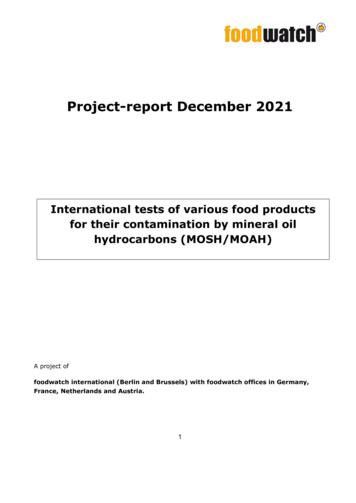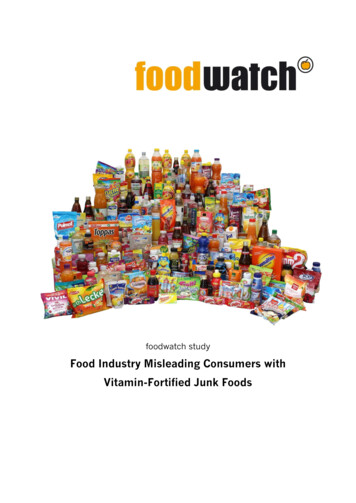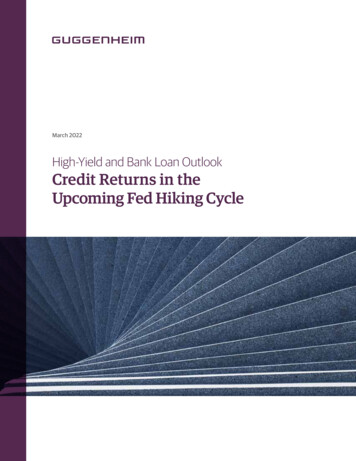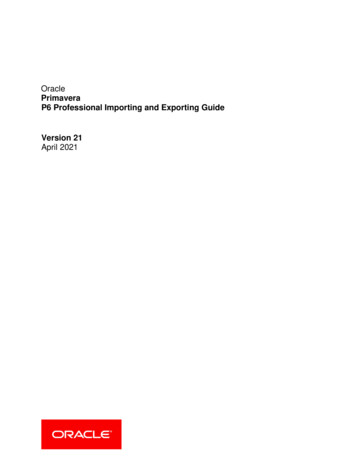
Transcription
Project-report December 2021International tests of various food productsfor their contamination by mineral oilhydrocarbons (MOSH/MOAH)A project offoodwatch international (Berlin and Brussels) with foodwatch offices in Germany,France, Netherlands and Austria.1
Executive summaryWithin the framework of an international product test, various food products were testedfor their content of mineral oil hydrocarbons (MOSH/MOAH).The selected products were purchased in the 5 different countries: Germany, France, theNetherlands, Austria and Belgium.MethodIn total, 152 different food products were analysed for their content of mineral oilhydrocarbons (MOSH/MOAH).The analytical methods used for the determination (online LC/GC-FID) and verification ofthe results (GC*GC-MS) correspond to the recommendations of the Technical Guidanceof the European Commission, Joint Research Centre (JRC) for the current EU-widemonitoring for the determination of MOSH/MOAH in foodstuffs. [7] The chemical analysisof the products was carried out in 2 different laboratories in order to guarantee the highestpossible and feasible precision of the analytical results. The verification and identificationof the marker compounds of the results was performed by GC*GC-TOF technique afterfractionation of the corresponding samples.ResultsMOAH:Positive levels of MOAH were found in 19 out of 152 samples (12 %).The levels found ranged from 0,63 mg/kg to 82 mg/kg.MOSH/POSH:In 140 from 152 (92 %) tested products MOSH/POSH were detected above the limit ofquantification of 0.5 mg/kg.The values range from 0,5 mg/kg up to 1152 mg MOSH/POSH/kg of product.The limit of quantification (LOQ) for the method used (online LC/GC-FID) was usually 0.5mg/kg. For a few samples with a problematic matrix and interferences, the LOQ was 1.0mg/kg.2
Conclusion/Evaluation of the resultsThe results clearly demonstrate that the MOAH percentage in the positively testedproducts is an indication that they are contaminated with a mineral oil which isinsufficiently purified.Food grade mineral oil saturated hydrocarbons (MOSH) (white oils) are reported tocontain less than 1 % of MOAH [7].The analytical verification of the positive results for corresponding marker substances andsubstance groups was carried out using a technically sophisticated procedure (GC*GCTOF). These tests proved the mineral, fossil origin of the detected mineral oilcontamination.It is not possible to make a statement about the potential source of the mineral oilcontamination. Contamination can occur during the whole production chain, as well asthrough the packaging material.In 133 products (87,5%) no MOAH could be determined. This means that it is technicallypossible to produce products without detectable content of MOAH. However, in order tocomply with the minimisation principle (ALARA), actions should be taken immediately toensure that the products concerned meet these requirements, which means that noMOAH should be detectable.foodwatch demands:foodwatch calls on all manufacturers / private brand retailers to:1. immediately initiate public product warnings in all Member States where theirMOAH-contaminated products are sold and immediately withdraw the productsfrom sale;2. prevent any contamination with MOAH mineral oil components suspected of beingcarcinogenic as well as to publicly commit to selling only food products that do notcontain detectable MOAH.foodwatch calls on all relevant authorities at national and EU level, to1. clarify by law that the analytical detection of MOAH in accordance with the relevantJRC guideline will result in the product not being marketable in the sense of Article14 of the General Food Law (178/2002).3
2. establish immediately corresponding requirements for MOAH in the EUcontaminants legislation for all food categories and not to allow any exceptions.3. lay down immediately requirements for MOSH in the EU contaminants legislationfor all food categories which, in accordance with the ALARA principle, only allowdeviations from a regular maximum level of 2 mg MOSH / kg food if there is ascientifically justified need for this. The exceptions are to be defined as narrowly aspossible with regard to both the food categories and the exception for exceeding 2mg MOSH/kg food.Table of contents1. Project target2. Introduction3. Health risks4. Sampling5. Test procedure and analytical methods6. Test results7. Interpretation and discussion8. Appendix4
1.Project target Determination of mineral oil hydrocarbons (MOSH/MOAH) in several different foodmatrices. Comparison and evaluation of the results of different EU Member States (Germany,France, Netherlands, Austria and Belgium) Test for mineral oil hydrocarbons in different food matricesooooo30 products from France27 products from Netherland39 products from Germany36 products from Austria20 products from Belgium Comparison and evaluation of the results in the products Summary and publication of results2.IntroductionMineral oils have been found in numerous foods such as rice, pasta, chocolate and edible oils, butcan also be found in packaging, children's toys, animal feed and cosmetics. [1]Packaging materials made of recycled paper can transfer mineral oils to food either through directcontact with the food or in a gaseous phase, i.e. through so called migration.In addition, mineral oils can enter foodstuffs at all stages of the processing chain, from harvesting,through further processing, to packaging. In the environment there can also be a certain backgroundpollution.But mineral oils are also used specifically by the food industry, for example, as dust binders, lubricantsin production machines, as release agents, as polishing agents (on fruits) or in adhesives in packaging.5
3.Health risksAccording to the European Food Safety Authority (EFSA) and the German Federal Institute for RiskAssessment (BfR), MOSH and MOAH have different toxicological potential. [1, 2]MOSH can be easily assimilated by the body and accumulate in fatty tissue. In experiments withrats, these led to damage in certain organs. Depending on the chain length and viscosity, MOSH canaccumulate in organs of the human body, some fractions are of concern according to the EFSA.However, only MOSH with a chain length greater than C16 are accumulated. [1]The intake of MOAH should generally be avoided as "a possible carcinogenic potential [.] cannot beexcluded" [2].Since, in addition, no toxicological data are available for evaluation so far, no tolerable intake hasbeen derived to date. [2]A final risk assessment by EFSA is still pending. However, in January 2017, the European Commissionadopted a recommendation for the monitoring of "mineral oil hydrocarbons in foods and materialsand articles intended to come into contact with foods". The resulting data will then be madeavailable to EFSA for evaluation. [4]According to the German Federal Institute for Risk Assessment (BfR), it cannot be ruled out thatcarcinogenic substances may be present in this fraction of MOAH. The Federal Institute for RiskAssessment (BfR) therefore demands the greatest possible minimisation for MOAH in foodstuffs(ALARA principle: "As Low As Reasonably Achievable"). [1]The opinion of the BfR is also shared by EFSA. [2]Given the genotoxic and mutagenic nature demonstrated for certain MOAHs, the French Agency forFood, Environmental and Occupational Health & Safety (ANSES) [10] believes that priority should begiven to reducing the contamination of food by these compounds. ANSES recommends limitingconsumer exposure to MOHs, and to MOAHs in particular, by acting initially on the main sources ofmineral oils in paper and cardboard packaging. ANSES recommends the use of barriers to limit themigration of MOHs from packaging into foods.In July 2019, a study by the Dutch National Institute for Public Health and the Environment (RIVM)was published, for which new toxicological data since the last EFSA-Opinion in 2012 were evaluatedand linked to consumption data. The RIVM concluded that dietary exposure to MOSH had no healtheffects on the Dutch population. In addition, the migration of MOSH from recycled packaging intofood contributes only to a small extent to the overall dietary exposure.6
The focus should be on exposure to MOAH, as substances contained in this fraction may have acarcinogenic effect. However, this does not mean that all mineral oils containing MOAH are alsocarcinogenic, but rather that a distinction must be made between the sources. Those containingpotentially carcinogenic MOAH compounds should be minimised. [5]For the risk assessment of MOAH found in food, it is important to distinguish between differentsources of MOAH. MOAH derived from crude oils or oils not sufficiently purified, as well as MOAHfrom combusted (or heated) mineral oils are carcinogenic and therefore, these contaminationsshould be avoided as much as possible.The risk assessment of the entire group of Mineral Oil Hydrocarbons (MOH) is subject to gaps ofknowledge. The toxicological relevance of effects shown for MOSH in rats for humans is questioned.For MOAH, with a possible mutagenic and carcinogenic potential, there are no dose response dataavailable.[5]Methods to discriminate between different MOAH in mixtures are currently not available. That iswhy it is important to distinguish between the different sources of contamination for MOAH, assome contain harmful MOAH, where others do not.[5]Benchmark levels for mineral oil hydrocarbons (MOH) in foods” in GermanyIn June 2018, in Germany the Consumer Protection Consortium of the Federal States (LAV) and theFood Industry Federation Germany (“Lebensmittelverband”) launched a joint project to derive socalled „Benchmark levels for mineral oil hydrocarbons (MOH) in foods”. [6]Based on a comprehensive data collection, the first list of benchmark levels for three foodcategories was published in March 2019. This was updated twice (June 2020 and August 2021) andsupplemented by other additional product categories. In the latest version (August 2021), eightproduct categories are listed and the values represent the state of good manufacturing andpackaging practice. For MOAH, in Germany food control authorities and food industry have agreed that theanalytically achievable limit of quantification (LOQmax according to the JRC technicalguidance) is applicable for each of the eight product categories listed. [6]“Due to insufficient data” oils/fats obtained from tropical plants (e.g. coconut oil) have up tonow not been included in that list. [6]For MOSH there are differentiated benchmark levels which vary in a range from 4 mg/kg(for example for nuts, oilseeds, coconut, peanuts and dried fruit) up to 22 mg/kg (milk andmilk products).7
11The analytical methods are being continuously optimized and the limits of quantification for mineral oil hydrocarbons(MOSH/MOAH) are being reduced. This is represented in the Standard Method of the German Society for Fat Science(DGF) C-VI 22 (20) "Mineral oil constituents, saturated hydrocarbons (MOSH) and aromatic hydrocarbons (MOAH) withonline coupled LC-GC-FID method for low limits of determination" published in December 2020. With this method it ispossible to quantify mineral oil hydrocarbons with improved precision and comparability up to a value of 0. 5 mg/kgor 1.0 mg/kg in various foods or oils and fats.The LOQ-t is the analytically achievable quantification limit for the majority of matrices of each food category, whereasthe LOQ-max should not be exceeded for any analytical methods used in MOSH or MOAH analysis. [7]foodwatch demands that in the future the identification of the maximum acceptable MOAH content as “nonquantifiable” (”n.q.”) has to make use of the achievable limits of determination (LOQ-t).8
In 2019, immediately after foodwatch’s publication of MOAH-findings in infant formula, EFSA published anew “Technical Report: Rapid risk assessment” on the potential risk to public health from contamination ofinfant formula and follow-on formula by aromatic mineral hydrocarbons. It concludes that hazardcharacterisation is not possible due to the lack of relevant dose-response data and the absence ofinformation on the presence of the more harmful 3- to 7-ring MOAH [11].4.SamplingThe sample purchases of the products took place in parallel in all five countries from the first weekof August 2021 to the last week of October 2021.The investigations and verification of the results have been carried out from August 2021 toDecember 2021.5. Test procedure and analytical methodsQuantitative determination and verification of analytical results is an essential and important part ofproduct testing.In order to ensure that the product test has the highest possible precision, reproducibility and validity,the quantitative determination of the products was carried out in 2 different laboratories.This means that for all products with MOAH contents above 0.5 mg/kg ( Limit of Quantification) thedeterminations were analysed in another laboratory to verify the MOSH and MOAH results.The following requirements had to be met by the participating laboratories: The participating laboratories needed to have a substantial experience in the field of theanalysis of mineral oil hydrocarbons. The laboratories must certify a validated method and periodically participate inproficiency tests and interlaboratory comparisons for mineral oil (MOSH/MOAH)analysis.9
The quantification of the MOSH/POSH and MOAH should be performed in alllaboratories using the Online-LC/GC-FID method. This is the method of choicerecommended by the European Commission, Joint Research Centre (JRC) TechnicalGuidance for the current EU-wide monitoring for the determination of MOSH/MOAH infood. [1,2,7,8,9] Sample preparation MOSH fraction: Determination after extraction or digestion,saponification of product and a) clean up with aluminium oxide or b) without clean upstep. Sample preparation MOAH fraction: Extraction or digestion, saponification of theproducts with subsequent clean-up of the extract with epoxidation.The verification of positive results to determine typical markers and substances for MOSH and MOAHfractions are performed by mass specific detection. For this step the method of choice is twodimensional gaschromatographic separation and mass specific detection, see [7, 8, 9]. Thisverification and identification of markers was performed using GC*GC-TOF.6.Test resultsAll products were analysed to determine which products were contaminated with mineral oil.Products with amounts above 0.5 mg/kg MOAH were analysed in a second replicate analysis. Inaddition, for samples with amounts above 0.5 mg/kg MOAH, another sample from a different batchwas purchased if possible and analysed.To be sure that there is no cross contamination, from all of the products with MOAH contents above0,5 mg/kg a second container of the same batch was analysed.Verification with GCxGC-TOF: In addition, a confirmatory analysis of these products was carried outin another laboratory. For all products with positive MOAH results, the verification of the results andthe test for markers was performed in two laboratories using GC*GC-TOF technology.The results of laboratory 1 for all products are shown in Tables 1 to 52.2Method: Online-LC/GC-FID;MOSH: Saponification of sample, if necessary cleanup step, removal of natural alkanes withAluminiumoxide;10
Table 1: Test results FranceNo.Product nameBatch numberExpiration dateMOSH/POSH(C10-C50)MOAH(C10C50)1Vigean huile de Coco France# 20-062A02.03.221,4 mg/kg 0,5mg/kg2Pate à tartiner Bio Lucien Georgelin# 16:13J12/05/20243,8 mg/kg 0,5mg/kg3Nutella Pate à tartiner aux noisetteset au cacao200 g France# L076RV02/20223,0 mg/kg 0,5mg/kg4Vahiné Noix de coco rapée#L109707/04/225,6 mg/kg 0,5mg/kg5Monoprix Poudre instantanée goutchoco# L109003.2023 11:541,4 mg/kg 0,5mg/kg6Maggi Bouillon Kub Volaille France# 1061036403.20222,7 mg/kg 0,5mg/kg7Lotus Biscoff the original speculoos# L114130921.06.20223,0 mg/kg 0,5mg/kg8Lidl Choco Nussa# RA 8009123012554816.09.225,5 mg/kg 1,0mg/kg9Knorr Bouillon de légume sans sel# L11450D09806/2022417 mg/kg44mg/kg# 10082210/08/202136 mg/kg5,3mg/kg# 22111010/11/202264 mg/kg5,0mg/kg# CB0212 412/08/22 0,5 mg/kg 0,5mg/kg# L11650U09812/2022369 mg/kg40mg/kg# L11670U09812/2022574 mg/kg48mg/kg# I:20103030-10-21 16:19:50 0,5 mg/kg 0,5mg/kg10111213Jardin Bouillon cube légumes sans selKara Creme de Coco FranceKnorr Bouillon aux herbes et avec del'huile de oliveCreme de coco legere Bjorg FranceMOAH: Saponification, cleanup step and removal of interferences with epoxidationTotal Amount Result calculated to DGF method C-VI-22, Dec. 202011
1415Banania l'original# L114105 20231,3 mg/kg 0,5mg/kg# 0950H001/202315 mg/kg2,5mg/kg# 0205Y103/202326 mg/kg2,0mg/kgAuchan Pouce Bouillon de boeufdeshydraté16Nesquik All natural 350 g# 10530835U1A11/20214,8 mg/kg 0,5mg/kg17Oréo original - 220g#OVI051192131/05/20222,3 mg/kg 0,5mg/kg18SuzyWan Creme de Coco France# 5A601103C18GF9913/04/2022 0,5 mg/kg 0,5mg/kg19Chocapic de Nestlé# L1148083800E105/2022 0,5 mg/kg 0,5mg/kg20Cruesli Chocolat Noir France# 153B 1R05 03 223,8 mg/kg 0,5mg/kg21Kellogg's Extra Chocolat Noir etnoisettes grillées# SA 2SN05/07/222,3 mg/kg 0,5mg/kg22Chabrior Muesli Crisp chocolat au laitFrance# 13:14 L128/05/20223,5 mg/kg 0,5mg/kg23Danette Chocolat# Z822522/090,5 mg/kg 0,5mg/kg24Herta Trésor de Grand-mèrefeuilletée# 1232001900 E021/09/20212,0 mg/kg 0,5mg/kg25MARQUE REPÈRE (E.LECLERC) Lasablée - tablier blanc# D2043233903/10/210,7 mg/kg 0,5mg/kg26CARREFOUR Pâte feuilletée Classic# 00 JT234/1836H22/09/20211,8 mg/kg 0,5mg/kg# L12040409805/11/20215,4 mg/kg1,0mg/kg# L12590409830/12/202138 mg/kg1,9mg/kg27Fruit d'or- oméga 328Pate brisée- Monoprix# D2 025732518/09/212,3 mg/kg 0,5mg/kg29LIDL Pâte brisée - Toque du chef# 59UH232/3443H09/09/20211,4 mg/kg 0,5mg/kg30CROUSTIPATE Feuilletée avec de lafarine de riz# L/RD 18/09/2118/09/21 02:541,0 mg/kg 0,5mg/kg12
Table 2: Test results NetherlandNo.Product nameBatch numberExpiration dateMOSH/POSH(C10-C50)MOAH(C10-C50)1LU Prince Start Naturel Cookies300 g# OHF4012312 219:2231.03.20223,2 mg/kg 0,5 mg/kg2Bolletje SCHUDDEBUIKJESSpeculaas 300 g01-01-20223,7 mg/kg 1,0 mg/kg3De Ruijter Vlokfeest 300 g# L22 03:0508-20223,3 mg/kg 1,0 mg/kg4BE-KIND Caramel Almond & Seasalt Bars# 121E22GU0116:4928.08.2022 0,5 mg/kg 0,5 mg/kg# L11270R09814:4311/2022609 mg/kg36 mg/kg# L11660D09814:4412/20221152 mg/kg58 mg/kg5Knorr Groente bouillon# L018278B 18:416Maggi Kippen bouillon# 11100364 13:3304/20224,8 mg/kg 0,5 mg/kg7Liga Milkbreak Melk Biscuits# OHT091 221 13-700:4028/02/20221,6 mg/kg 0,5 mg/kg8AH Bouillon, Bospaddenstoel# 15.04.202315.04.2023 0,5 mg/kg 0,5 mg/kg9Sultana Naturel Fruit Biscuits# LZ11956 03:2603/2022 0,5 mg/kg 0,5 mg/kg10Kellog's Tresor Melkchocolade#L1167 03451012:1312/04/221,2 mg/kg 0,5 mg/kg11Calvé Pindakaas 350 g# L118900A6905:3103/04/2022 0,5 mg/kg 0,5 mg/kg12Nutella Hazelnootpasta metcacao# L161RV--C09:4610/06/20223,8 mg/kg 0,5 mg/kg13Lotus Biscoff THE ORIGINALspeculoos# L1186409/192505/08/20222,9 mg/kg 0,5 mg/kg14Kellog's Froot Loops Mixed#L1 160 03451012:299-6-210,80 mg/kg 0,5 mg/kg15Calvé Pindakaas 350 g18/04/220,56 mg/kg 0,5 mg/kg# L120300A6913
16Trek Protein Havermout Repen# L5 18-07-202218-07-20221,9 mg/kg 0,5 mg/kg17Jumbo Groente Bouillon# 62517-101711-09-20221,8 mg/kg 0,5 mg/kg18Cruesli Kids Chocolate Flavour# 153C 22:12 2R05-03-20229,7 mg/kg1,4 mg/kg19Bladergeeg op een rolAlbert Heijn#871890745319606/10/20213,4 mg/kg 0,5 mg/kg20Danerolles croissants classic# 06:25 0221/09/211,9 mg/kg 0,5 mg/kg21VioLife Greek White# 21175A24/04/20226,7 mg/kg 0,5 mg/kg22AH Plantaardige plakken#SN1792E25/12/20216,5 mg/kg 0,5 mg/kg23AH Verse original croissants#0222920:35 s125/10/213,6 mg/kg 0,5 mg/kg24Oatly! Romige haver spread# AA00037908-12-20212,3 mg/kg 0,5 mg/kg25Jumbo Bladerdeeg metbakpapier# 12111400616-09-20212,1 mg/kg 0,5 mg/kg26Koopmans Bladerdeeg Origineel# L454121131 10:1611-20224,0 mg/kg 0,5 mg/kg27Consenza Puff Pastry# 30-05-2230-05-221,0 mg/kg 0,5 mg/kg14
Table 3: Test results GermanyNo.Product nameBatch numberExpirationdateMOSH/POSH(C10-C50)MOAH (C10C50)1BEN & JERRY'S Cookie Dough# L1168BM02012/20222,1 mg/kg 0,5 mg/kg2Rapunzel Tiger Creme# 4000010105A19.10.20221,5 mg/kg 0,5 mg/kg3Alnatura Haselnuss-Nougat# 400000944501.09.20224,6 mg/kg 0,5 mg/kg4Gut & Günstig FrischerBlätterteig# 3232314.09.212,8 mg/kg 0,5 mg/kg5Henglein Frischer Blätterteig#32323 06:1414.09.213,5 mg/kg 0,5 mg/kg6Veganz Geniesserstück# 60852705118.12.20214,1 mg/kg 0,5 mg/kg7Bedda Scheibenkäse# 22.12.202122.12.20211,0 mg/kg 0,5 mg/kg8Smarties Pop up Eis# L-AR1070A103/20231,3 mg/kg 0,5 mg/kg9Simply V Natur#1312012018.10.20212,4 mg/kg 0,5 mg/kg10Knack & BackSonntagsbrötchen#0200 15:505203/10/2021 0,5 mg/kg 0,5 mg/kg11Rewe Bio Vegan Mozzarisella#28420/10/202112 mg/kg 0,5 mg/kg12Schöller Kaktus 4 Friends#LFE 1133 22FR05/20236,1 mg/kg 0,5 mg/kg13Rewe Beste Wahl Blätterteig#3133321.09.214,3 mg/kg 0,5 mg/kg14Nestle Nesquik Snack# L1209201.10.212,5 mg/kg 0,5 mg/kg15Knorr Feinschmecker SauceHollandaise# L11380D80311/20223,7 mg/kg 0,5 mg/kg16De Beukelaer Prinzenrolle# 174V101.04.224,6 mg/kg 0,5 mg/kg17Knorr Helle Soße# L113111/20223,4 mg/kg 0,5 mg/kg15
18Knorr Sauce Hollandaise# L 10780277714/12/20216,0 mg/kg 0,5 mg/kg19Kölln Knusper Klassik HaferMüsli# L127307.06.20221,8 mg/kg 0,5 mg/kg20Vitalis Schoko Müsli#L20808.221,1 mg/kg 0,5 mg/kg21Pfanni Kartoffelklöße# L 10881080506.2022 0,5 mg/kg 0,5 mg/kg22Storck Toffifee#MB34M01.03.221,1 mg/kg 0,5 mg/kg23Ferrero Yogurette# L175RG-3705.01.20222,1 mg/kg 0,5 mg/kg# L089RG 19:4130.03.202214 mg/kg2,3 mg/kg# L272RG--18:2329.09.20229,8 mg/kg 1,0 mg/kg# 18:44 16.09.202216.09.20226,5 mg/kg1,1 mg/kg# 21:41 19.11.202219.11.20228,0 mg/kg1,2 mg/kg2425Ferrero NutellaZentis Nusspli Nuss NougatCreme26Ritter Sport Knusperkeks# H2P128060 08:4428.04.20221,3 mg/kg 0,5 mg/kg27Leibniz Pickup!# F130201.08.223,5 mg/kg 0,5 mg/kg28Güldenhof Geflügelsalamimit Pflanzenfett geräuchert# 14.10.202114.10.20211,6 mg/kg 0,5 mg/kg29Lindt Lindo Milch VollmilchChocolade mitzartschmelzender Füllung# L5701 13 007/202207/20225,5 mg/kg 0,5 mg/kg30Choceur Keks Milchcreme# L41292B 30.04.202230.04.20221,4 mg/kg 0,5 mg/kg31Le Gusto Klare Hühner Brühe# 03.09.202203.09.2022 0,5 mg/kg 0,5 mg/kg32ja! NussNougat Creme10-20224,0 mg/kg 0,5 mg/kg33Nusskati Nuss Nougat Creme30.06.226,4 mg/kg 0,5 mg/kg# L122164 10/2022# N1 07:06 30.06.202216
34nussetti Nuss Nougat Creme#L1215506/013103.09.20226,5 mg/kg 0,5 mg/kg35Biscoteria Pausenschnitte#17:12 B L13694030.05.20224,0 mg/kg 0,5 mg/kg36Carat Klare Gemüsebrühe#29.10.202129.10.20214,0 mg/kg 0,5 mg/kg# L221CH816x0502.2022325 mg/kg22 mg/kg# L1014CH816x2207.2022465 mg/kg28 mg/kg# L01600C098 06:5012/2021813 mg/kg52 mg/kg# L03360A098 11:0406/2022516 mg/kg82 mg/kg# 0342070F 14:2502.20224,0 mg/kg 0,5 mg/kg373839Knorr Fette BrüheKnorr Bratensaft BasisMaggi Fette Brühe17
Table 4: Test results AustriaNo.Product nameBatch numberExpiration dateMOSH/POSH(C10-C50)MOAH(C10-C50)1Billa Bio Nuss-Nougat-Creme#12621E 17:3107/20222,8 mg/kg 0,5 mg/kg2Nutella Nuss-Nougat-Creme# L146RV--C 10:5426/05/20224,1 mg/kg 0,5 mg/kg3Milky Way Cocoa Milk duocremeL21056 1WL25.02.20229,9 mg/kg3,1 mg/kg4Milka Haselnusscreme 350 g#2B00911134/000217.12.202111,0 mg/kg 0,5 mg/kg#L1113AQ816 *0710 202266 mg/kg6,4 mg/kg#L1218AR816 *0802 2023102 mg/kg7,0 mg/kg5Knorr Goldaugen6Maggi Rindfleischsuppe#10470824E102-202211 mg/kg 0,5 mg/kg7Knorr Bio Gemüse BouillonPulver# L10891N80909/20221,8 mg/kg 0,5 mg/kg8Suchard Express Kakao# L 0331 08:1302 02 20235,3 mg/kg 0,5 mg/kg9S Budget Instant Kakao#L 1301 09:0205 20231,1 mg/kg 0,5 mg/kg10Natur Pur Bio-Trink-Kakao# L138105 20232,7 mg/kg 0,5 mg/kg11Ja! Natürlich Bio Trinkkakao# L358006 20220,91 mg/kg 0,5 mg/kg12Benco Trinkkakao# ZBL07117 42 B28.04.231,8 mg/kg 0,5 mg/kg13Nestle Nesquik# 10900973 T09 20222,5 mg/kg 0,5 mg/kg14Soyananda Frisch Vegan Cheese"Creme Chesse"# 10.09.2110.09.217,4 mg/kg 1,0 mg/kg15MozzaRisella Klassisch VeganCheese "Mozzarella"#26103/10/202116 mg/kg 0,5 mg/kg16Violife Greek White VeganCheese "Feta"# 21159 B08/04/20225,2 mg/kg 0,5 mg/kg18
17Wilmersburger PizzaschmelzVegan Cheese# 179-210106.09.20219,3 mg/kg1,7 mg/kg# 221-210118.10.20217,3 mg/kg1,8 mg/kg18Clever Blätterteig Puff Pastry# 12111210328.08.20212,2 mg/kg 0,5 mg/kg19Tante Fanny Frischer Blätterteigverfeinert mit Butter#12111297606.09.20212,0 mg/kg 0,5 mg/kg20S Budget Bätterteig05 09 212,5 mg/kg 0,5 mg/kg21Penny Ready Frischer Blätterteig#12111327808 09 20212,4 mg/kg 0,5 mg/kg22Oreo Original Cocoabiscuits filledwith Vanillacream# OPA6112132 L431/05/20222,2 mg/kg 0,5 mg/kg# L497130.11.302147 mg/kg3,3 mg/kg#L374131.05.202210 mg/kg0,98 mg/kg23#121112826Lindt Lindor Milch24Milka MMMAX Schoko&Keks# 00V081236212.06.20223,2 mg/kg 0,5 mg/kg25Manner Haselnuss Mignon# L1588113919.08.20224,3 mg/kg 0,5 mg/kg26De Beukelaer Prinzen Rolle# 081 T201.02.221,7 mg/kg 0,5 mg/kg27Napoli Dragee Keksi Classic# L5752111828.04.20223,4 mg/kg 0,5 mg/kg28Niemetz Schwedenbomben# L21216131.08.218,2 mg/kg 0,5 mg/kg29Kinderschokolade# L151RG--0811.01.20221,8 mg/kg 0,5 mg/kg# 18.04.202218.04.2022117 mg/kg12 mg/kg# 27.07.202227.07.2022121 mg/kg7,7 mg/kg# 585131.01.20228,6 mg/kg 0,5 mg/kg3031Alnatura Bio Hühner BouillonLindt Lindor Dunkel19
32Manner WeihnachtssterneNougat# L5180122303 20226,6 mg/kg 0,5 mg/kg33Casali Tor Nusskugeln# L5117125303 20222,9 mg/kg 0,5 mg/kg34Kufferle Schoko Schirmchen#11 L667106 20226,8 mg/kg 0,5 mg/kg35Betthupferl Pischinger DarkChocolate# L24331.05.20225,6 mg/kg 0,5 mg/kg36ILDEFONSO Weihnachtsbehang# L5117119003 202292 mg/kg10 mg/kg20
Table 5: Test results BelgiumNo.Product nameBatch numberExpiration dateMOSH/POSH(C10-C50)MOAH(C10-C50)1Madeleine Chocolat# 29/10/2021 G29/10/20213,9 mg/kg 0,5 mg/kg2Venz Flocons de crocodile# L19182404.20222,8 mg/kg 0,5 mg/kg3KWATTA puur fondant# L1152209/120307.20225,9 mg/kg 0,5 mg/kg4Delhaize Bio cookies chocolatechip# 2117019.02.20222,4 mg/kg 0,5 mg/kg5Knorr Groenten LegumesBouillon#L104700N3208.20221,9 mg/kg 0,5 mg/kg# L1069A8816*0709.202295 mg/kg6,4 mg/kg6Knorr Finesse Groenten LegumesBoullion# L1069A8816*0609.2022123 mg/kg8,4 mg/kg# C02-21054-G18: 12-05423.08.20227,7 mg/kg0,71 mg/kg# C02-21060-G20: 55-06029/08/20227,5 mg/kg0,63 mg/kg7Delhaize Pate a tartiner auxnoisette (bio)8Whole Earth peanut chocohazelnut spread# 98123 02:15D02.06.20221,3 mg/kg 0,5 mg/kg9Penotti Praline spread#L10673305.20226,5 mg/kg 0,5 mg/kg10Delhaize Speculoos spread# L10352804.04.20222,6 mg/kg 0,5 mg/kg11DelHaize Bladerdeeg- PateFeuilletee#D 4G071933802/10/212,7 mg/kg 0,5 mg/kg12DelHaize Kruimeldeeg- PateBrisee#D2 135734408/10/211,1 mg/kg 0,5 mg/kg13DelHaize Bladerdeeg- PateFeuilletee- Blaetterteig bio# 01P08 V 09:29D28/9/211,2 mg/kg 0,5 mg/kg14Violife Greek White# 21176 A 08:1725/4/20226,2 mg/kg 0,5 mg/kg15Violife Mozzerrella flaverouredgrated#21145B 17:5325/01/20222,3 mg/kg 0,5 mg/kg21
16Nurishh Mozzerellaflaveroured grated# SN1831E 06:5630/10/20212,9 mg/kg 0,5 mg/kg17ALPRO cooking coconut# BA 2416 17:2014/03/2022 0,5 mg/kg 0,5 mg/kg18Boerinneke sans lactose gluten(bio)# L117928.09.20222,9 mg/kg 0,5 mg/kgL250RV --C 12:4707/09/20224,1 mg/kg 0,5 mg/kg207.NutellaInterpretation and discussionMOSH/POSH : For food products there are currently no agreed acceptable values of contaminationpublished on EU-level.3 All products, however, show a wide range of contamination from MOSH/POSH rangingfrom non-detectable (below 0,5 mg/kg) to 1152 mg/kg.MOAH: For food products there are currently no agreed acceptable values of contaminationpublished on EU-level. The MOAH contents in all products show a wide range of contamination. They varyfrom non-detectable (below 0,5 mg/kg) to 82 mg/kg.3Due to the persisting lack of legal maximum values all over Europe the German competent authorities together with the foodindustry published “Benchmark levels for mineral oil hydrocarbons (MOH) in foodstuffs” (Update August 2021). For all food groupscovered any verification of MOAH is not accepted. And it appears remarkable for comparison reasons that the sum of MOAH (C10C50) in 19 out of 152 samples is above the “benchmark level” of 0.5 mg/kg, i.e. level of quantification for the specified differentmatrices.22
In all products with MOAH contents above 0.5 mg/kg, the percentage of the MOAH fraction to thetotal mineral oil content was calculated. These proportions are all in the range from 4,7% MOAH to23,8% MOAH.Food grade mineral oil saturated hydrocarbons (MOSH) (white oils) are reported to contain lessthan 1 % of MOAH. [7]For the majority of the products tested positively for MOAH ( 0.5 mg/kg), a second different batchwas tested. In most of the products of the second batch tested, the content of MOAH wasconfirmed.However, it also showed that in the products of Nutella (Germany), the first batch had a MOAHcontent of 2.3 mg/kg and in the second batch no MOAH content could clearly be identified in therange of 1.0 mg/kg. Similarly, Lindt Lindor milk (Austria), here the first batch had a MOAH contentof 3.3 mg/kg and the second with 0.98 mg/kg. Thus, lower MOAH contents could be determined inother batches.Typical marker substances could be identified in the MOSH and MOAH fractions of all theseproducts.Conclusion: The results of the ratio between MOSH and MOAH (MOAH content in whole mineraloil) of the products tested positive for MOAH is an indication that the products arecontaminated with a mineral oil which is insufficiently purified. The verification of the positively tested products (MOAH above 0,5 mg/kg) by usingGC*GC-TOF all showed typical markers and typical compound classes in both theMOSH and MOAH fraction. The results for MOAH here should be evaluatedaccording to the ALARA (As Low As Reasonably Achievable) principle. It would begood practice f
TOF). These tests proved the mineral, fossil origin of the detected mineral oil contamination. It is not possible to make a statement about the potential source of the mineral oil contamination. Contamination can occur during the whole production chain, as well as through the packaging material. In 133 products (87,5%) no MOAH could be determined.










